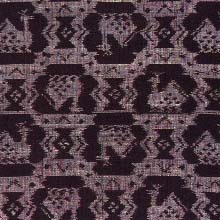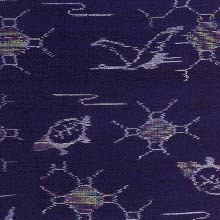Weave (p. 114 )
1. Produced in Hirosemachi Nogigun, Yasugi City, Shimane Prefecture.
2. Characteristics: Hand woven cotton fabric with "Kasuri" designs which look more like folk craft. One of the Three Figure Kasuri in the Sanin District. Designs are delicately woven. It was once praised as good for its large designs in comparison to the middle sized designs in "Bingo(Hiroshima Prefecture) Gasuri" and small designs in "Kurume Gasuri." Most of the designs are "Sho-Chiku-Bai"(Pine, Bamboo, Plum) and "Tsuru-Kame"(Crane,Turtle), both of which are regarded as being auspicious in Japan. The futon mat in which "Hirose Gasuri" is used was a bridal mat as well as a death mat. It was a custom for the bride to take a futon mat made with Hirose Gasuri to her bridegroom as one of the bridal items. After it was used on the wedding night the mat was carefully kept and was used again as a death bed for the same woman. A special technique called "Makase" is used in this Kasuri weaving. The part to be left undyed is not marked with Chinese ink(as is usual in most Kasuri weaving) but it is copied onto the pattern paper.
3. Uses: Clothing, bedding, cushions
4. History: Hirose Gasuri was originated in Hirose where a doctorユs wife started weaving it after she studied the technique of dyeing and weaving "Yumigahama Gasuri" in Yonago in the Bunsei Era(1818-30). After that, the production flourished as the feudal government protected it. In and after the Koka Era(1844-48), an official designer of the government created a large design, which became widely known as characteristic of Hirose Gasuri. Its production equaled that of "Kurume Gasuri" in the Meiji Period. In the Meiji Era starting in 1897, some changes in the loom(from low to raised looms) and the threads(from hand to machine spun) were made for mass production. However, a big fire in 1915 and the WWII damaged its production. It is being revived today by a man named Amano, who is good in the technique of Kasuri weaving.




